| کد مقاله | کد نشریه | سال انتشار | مقاله انگلیسی | نسخه تمام متن |
|---|---|---|---|---|
| 86591 | 159199 | 2014 | 8 صفحه PDF | دانلود رایگان |

• Home ranges were smallest (20–226 ha) in 1–2 year post-summer wildfire habitat.
• Home ranges were intermediate (67–790 ha) in mountain pine beetle infestations.
• Black-backed Woodpeckers selected trees in high basal area (>27 m2/ha) sites.
• Black-backed Woodpeckers selected relatively large diameter (>27 cm) dead trees.
• Black-backed Woodpeckers rarely used 1-year post-fall prescribed fire habitat.
Black-backed Woodpeckers (Picoides arcticus) are a disturbance-dependent species that occupy recently burned forest and mountain pine beetle (MPB) infestations. Forest management practices that reduce the amount of disturbed forest may lead to habitat loss for Black-backed Woodpeckers, which have recently been petitioned for listing under the Endangered Species Act. We studied home range size and resource selection of Black-backed Woodpeckers occupying habitat created by summer wildfire, fall prescribed fire, and MPB infestations in the Black Hills, South Dakota. We studied home range size and resource selection by attaching radio-transmitters to adult Black-backed Woodpeckers. We estimated home range size using fixed kernel density techniques (n = 28 in habitat created by summer wildfire, n = 19 in habitat created by fall prescribed fire, and n = 27 in MPB infestations). We evaluated resource selection with a random-effects discrete choice model in a Bayesian framework (n = 5 in habitat created by summer wildfire, n = 16 in habitat created by fall prescribed fire, and n = 8 in habitat created by MPB infestations). Home range size was smallest in 1–2 year post summer wildfire habitat (mean home range size = 79 ha) and 2-year post fall prescribed fire habitat (mean home range size = 143 ha). Home range size was intermediate in MPB infestations (mean home range size = 307 ha) and was greatest in 3–4 year post fire habitat (mean summer wildfire home range size = 430 hectares, mean fall prescribed fire home range size = 460 ha). The relative probability that a Black-backed Woodpecker used a tree increased with increasing diameter at breast height (DBH) and basal area and was greatest on disturbance-killed trees. These results suggest 1–2 year post summer wildfire habitat may have the greatest relative value to Black-backed Woodpeckers and that MPB infestations may be more important as post-fire habitats age. We recommend retaining patches of 1–2 year post summer wildfire habitat that are at least 200 ha by exempting portions of recently burned forest from salvage logging. This recommendation can be accomplished by exempting salvage logging in summer wildfires <200 ha and retaining at least 50% of summer wildfires >400 ha. Ideally, recently burned forest patches should be composed of ⩾27 m2 basal area/ha of trees that burned at moderate or high severity, with at least 40% of the basal area composed of trees ⩾27 cm DBH.
Journal: Forest Ecology and Management - Volume 313, 1 February 2014, Pages 161–168